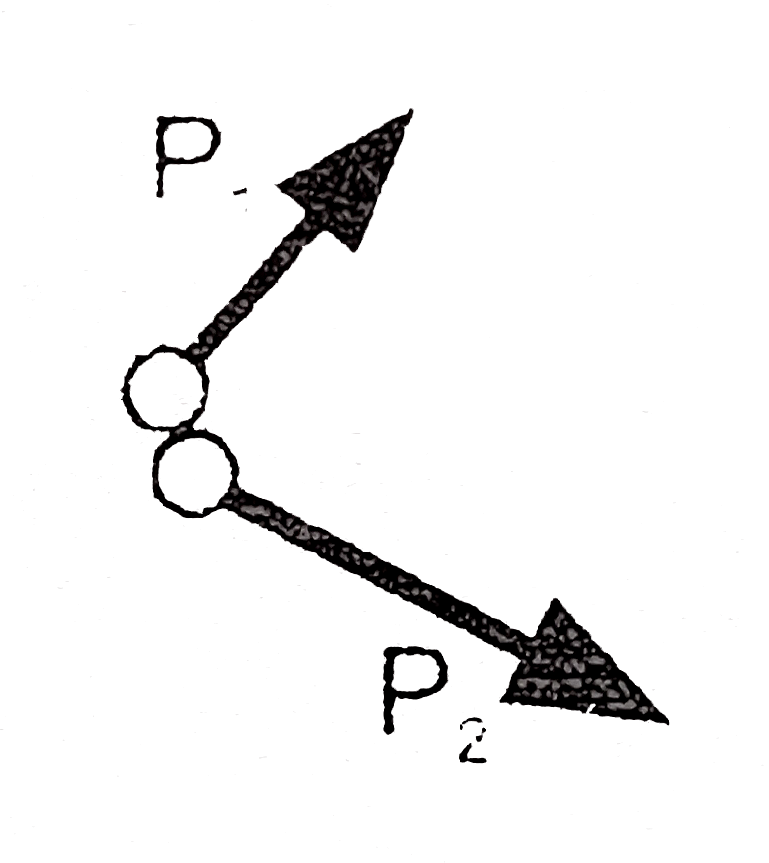Two electrons are moving with non-relativistic speeds perpendicular to each other. If corresponding de Broglie wavelengths are λ1 and λ2 their the Brogile wavelength in the frame of reference attached to their centre of mass is :
The correct Answer is:λ=2λ1λ2√λ21+λ22
Let ¯p1 and ¯p2 be the momenta of the two paritlces.
The velocity of the centre of mass

Hence, momentum of paritcles 1 in c.m. frame
→p1=m(→v1−→vcm)
=m→v1=m→p1+→p22m
=¯p1+¯p22
|→p1|=12√P21+P22−2P1P2cos90∘
hλ=12√h2λ21+λ22
Topper's Solved these Questions
- BOOK - RESONANCE ENGLISHCHAPTER - ATOMIC PHYSICSEXERCISE - Exercise ( Part II : Only one one correct type)37videos
ATOMIC PHYSICS
- BOOK - RESONANCE ENGLISHCHAPTER - ATOMIC PHYSICSEXERCISE - Exercise (2) Only one option correct type30videos
ATOMIC PHYSICS
- BOOK - RESONANCE ENGLISHCHAPTER - ATOMIC PHYSICSEXERCISE - Solved miscellaneous problems14videos
ATOMIC PHYSICS
- BOOK - RESONANCE ENGLISHCHAPTER - ALTERNATING CURRENTEXERCISE - HIGH LEVEL PROBLEMS11videos
ALTERNATING CURRENT
- BOOK - RESONANCE ENGLISHCHAPTER - CAPACITANCEEXERCISE - High Level Problems16videos
CAPACITANCE
Similar Questions
Two identical non-re,aticivistic particles move at right angle to each other. Possesing de Broglie wavelength λ1 and λ2 Find the Broglie wavelength of each particle in the frame of their centre of inertia.
View SolutionTwo particles move at right angle to each other. Their de Broglie wavelenghts are λ1 and λ2 respectively. The particles suffer perfectly inelastic collision. The de Broglie wavelenght λ, of the final particle, is given by:
View Solution
Knowledge Check
- Question 1 - Select One
Electrons with de-Broglie wavelength λ fall on the target in an X-ray tube. The cut-off wavelength of the emitted X-ray is
Aλ0=2mcλ2hBλ0=2hmcCλ0=2m2c2λ2h2Dλ0=λ
Calculate the de Broglie wavelength of an electron travelling at 1% of the speed of the light
View SolutionA proton and an electron are accelerated by the same potential difference, let λe and λp denote the de-Broglie wavelengths of the electron and the proton respectively
View SolutionA proton and an α-particle are accelerated, using the same potential difference. How are the de-Broglie wavelengths λpandλa related to each other?
View SolutionThe de-Broglie wavelength λnof the electron in the nth orbit of hydrogen atom is
View SolutionThe log - log graph between the energy E of an electron and its de - Broglie wavelength λ will be
View SolutionElectrons with de-Broglie wavelength λ fall on the target in an X-ray tube. The cut-off wavelength of the emitted X-ray is
View SolutionTwo particle are moving perpendicular to each with de-Broglie wave length λ1 and λ2. If they collide and stick then the de-Broglie wave length of system after collision is : (A) λ=λ1λ2√λ21+λ22 (B) λ=λ1√λ21+λ22 (C) λ=√λ21+λ22λ2 (D) λ=λ1λ2√λ1+λ2
View Solution

